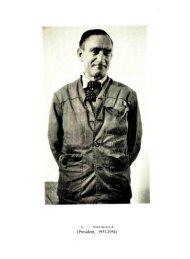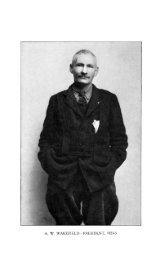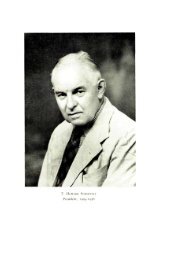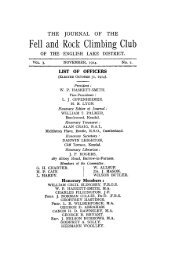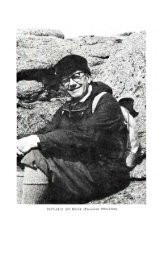Year of publication 1960 - Fell and Rock Climbing Club
Year of publication 1960 - Fell and Rock Climbing Club
Year of publication 1960 - Fell and Rock Climbing Club
Create successful ePaper yourself
Turn your PDF publications into a flip-book with our unique Google optimized e-Paper software.
John C. Lyth 45The rope is laid as in Fig. D, i.e. curled round <strong>and</strong> taken ahalf turn round itself. The karabiner is then snapped onto the doubled part <strong>of</strong> the rope, as in Fig. E, not through thesingle loop only. It is immaterial in which direction the hitchis laid with reference to the rope, as when the karabiner isheld <strong>and</strong> either end is pulled, the hitch adjusts itself throughthe karabiner.The advantages <strong>of</strong> the braking hitch are:(1) It is used with an ordinary karabiner.(2) It provides enormous braking effect without danger <strong>of</strong>over-heating metal, which could lead to melting <strong>of</strong> nylonrope.(3) The braking effect can be varied at will.(4) It can be applied in an instant at any point in the rope,without threading either end.(5) It costs nothing!I have thought it worth while to publish details <strong>of</strong> thisbraking hitch, which I designed some ten years ago, because<strong>of</strong> the many serious <strong>and</strong> <strong>of</strong>ten fatal accidents to climbers,resulting partly from the inability <strong>of</strong> the second to hold afalling leader. It is manifestly impossible for a woman orsmall man to do more than slightly check the fall <strong>of</strong> amoderately heavy leader who has come <strong>of</strong>f even a few feetabove. The gadgets on the market intended to brake such afalling leader are fairly expensive, some heavy <strong>and</strong> not easy toapply quickly. In fact, <strong>of</strong> the thous<strong>and</strong>s now climbing (inBritain alone), not many will carry them. But nearly allclimbers have a karabiner <strong>and</strong> sling; <strong>and</strong> if adopted as a matter<strong>of</strong> course, perhaps this braking hitch would help to solve theproblem <strong>of</strong> the weak second; <strong>and</strong> the belaying <strong>of</strong> the leaderwould become more than a psychological demonstration.POSTSCRIPT—THE LYTH HITCHBY J. ROBERT FILESJohn Lyth has demonstrated the value <strong>of</strong> his braking hitch inabseiling <strong>and</strong> as a safeguard used by a leader in bringing up hissecond man. He saw that a more important use might be to save afalling leader but could not find a climbing friend sufficientlyco-operative to prove the point.On his suggestion we joined him to carry out some tests using aten stone sack <strong>of</strong> stones as the 'leader.' This victim was pushed overthe edge <strong>of</strong> an old slate quarry in Borrowdale <strong>and</strong> allowed to fall








